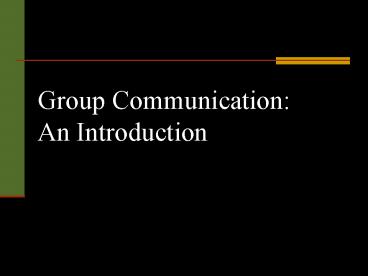Group Communication: An Introduction - PowerPoint PPT Presentation
1 / 29
Title:
Group Communication: An Introduction
Description:
'A competent group communicator is one who is able to interact appropriately and ... Which of these are intrinsic to working in groups? ... – PowerPoint PPT presentation
Number of Views:91
Avg rating:3.0/5.0
Title: Group Communication: An Introduction
1
Group CommunicationAn Introduction
2
A Focus on Task Groups
- Primary group A group that exists simply to
fulfill the basic need we have to associate with
others. - Secondary group A group that exists to
accomplish a specific instrumental task or goal.
3
A Focus on Becoming a Better Communicator
- Other competencies ...
- Technical
- Financial
- Material
- Administrative
- Etc.
4
A Focus on Developing Competence
- Understanding, appreciation, and some general
practical advice. - No step-by-step rules or recipes.
The person who knows how will always have a
job. The person who knows why will always be
his boss. Diane Ravitch - Historian, former US
Assistant Secretary of Education, research
professor at NYU Steinhardt School of Education
5
A Focus on Developing Competence
- Understanding, appreciation, and some general
practical advice. - No step-by-step rules or recipes.
- "A competent group communicator is one who is
able to interact appropriately and effectively
with others in small groups and teams" (p. 27). - You can be appropriate but NOT effective!
- You can be effective but NOT appropriate!
- Competence motivation, knowledge, and skill.
6
Communication is Transactional
- NOT Actional
7
Communication is Transactional
- NOT Interactional
8
Communication is Transactional
- BUT Transactional
9
Small Groups What?
- Small group of people
- How large does a group have to become before it
no longer feels like a group to you? - Meeting with a recognized common purpose
- Members feel a sense of belonging
- Members function to exert influence on one another
10
Small Groups Why?
- More information
- More creative
- Improved learning
- More satisfaction through participation
- Self learning
11
Small Groups Why Not?
- Pressure to conform
- Individual discussion domination
- Rely too much on others
- Takes more time
- Efficiency vs. Effectiveness???
Which of these are intrinsic to working in groups?
12
Communication Competencies for Effective Small
Groups
- Teamness as competence
- What is a team?
13
Teams vs. Groups
Roles Rules Goals Methods
See p. 8
14
Teams???
What makes an effective team? (See pp. 9-10)
15
Teams???
What makes an effective team member? (See pp.
10-11)
16
Levels of Human Assemblies
- Aggregates
Groups
Teams
17
What Makes the Difference?
18
What Makes the Difference?
- Awareness of and recognition of others as part of
the same assembly
What is the role of communication in this?
19
What Makes the Difference?
- Balance of individual and shared goals
What is the role of communication in this?
20
What Makes the Difference?
- Interdependence necessary for goal attainment
What is the role of communication in this?
21
What Makes the Difference?
- Amount of direct interaction among individuals
What is the role of communication in this?
22
What Makes the Difference?
- Membership selection criteria
What is the role of communication in this?
23
What Makes the Difference?
- Role clarity and differentiation
What is the role of communication in this?
24
What Makes the Difference?
- Level of real and perceived accountability
What is the role of communication in this?
25
What Makes the Difference?
- Emphasis on training and self-assessment
What is the role of communication in this?
26
What Makes the Difference?
- Existence of and nature of leadership
What is the role of communication in this?
27
What Makes the Difference?
- Development of unique, shared rituals and
celebration
What is the role of communication in this?
28
What Makes the Difference?
- Synergy Are the results less than, equal to, or
greater than the sum of the parts?
What is the role of communication in this?
29
An Early Self-Assessment
- Consider the groups of competencies on pp.
28-29. Which have been the least apparent in your
experiences with student project groups?































